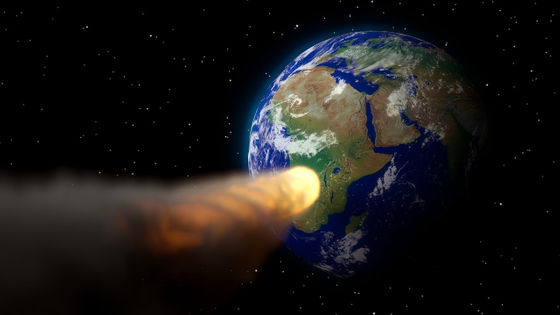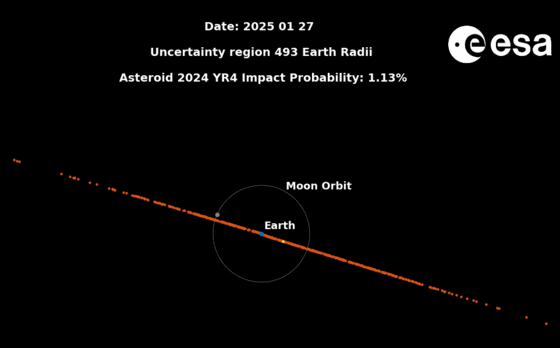The risk of the asteroid 2024 YR4 colliding with Earth has been reduced to 1 in 100,000, effectively making it zero and no longer considered a risk.

by
The European Space Agency (ESA) and NASA have announced that ongoing monitoring of the asteroid 2024 YR4, which was previously thought to have a realistic chance of colliding with Earth (about 1 in 33), has reduced the risk of a collision to virtually zero (about 0.001%) and is not expected to increase in the future.
Sentry: Earth Impact Monitoring
https://cneos.jpl.nasa.gov/sentry/details.html#?des=2024%20YR4
ESA - Asteroid 2024 YR4 no longer poses significant impact risk
https://www.esa.int/Space_Safety/Planetary_Defence/Asteroid_2024_YR4_no_longer_poses_significant_impact_risk
'No chance' of impact from asteroid 2024 YR4, say space agencies | Science, Climate & Tech News | Sky News
https://news.sky.com/story/no-chance-of-impact-from-asteroid-2024-yr4-say-space-agencies-13316954
'That's Zero Folks!': Asteroid 2024 YR4 is no longer a hazard | Live Science
https://www.livescience.com/space/asteroids/thats-zero-folks-asteroid-2024-yr4-is-no-longer-a-hazard
'2024 YR4,' discovered by the Asteroid Terrestrial Impact Last Warning System (ATLAS) in Chile on December 27, 2024, is estimated to be 40 to 90 meters wide, and the energy released if it falls to Earth is estimated to be about 8 megatons, equivalent to 500 times the atomic bomb dropped on Hiroshima. Some reports have called it the 'city killer.'
Orbit calculations increased the chances of 2024 YR4 falling to Earth on December 22, 2032, peaking at 2.8% according to ESA and 3.1% according to NASA.

After that, ESA revised down the probability of a collision to 0.001%, and NASA revised it down to 0.0017%, based on the data collected from observations up to February 24, 2025. As a result, 2024 YR4 was downgraded from level 3 to level 0 on
'Asteroid 2024 YR4 has been reclassified to level 0 on the Torino scale, meaning it is not at risk, because tracking its orbital path has reduced the probability of it intersecting with Earth below the threshold of 1 in 1,000,' said Richard Binzel, professor of planetary science at the Massachusetts Institute of Technology and creator of the Torino scale.
Below is an animation of the collision risk over time created by ESA, click to view a larger version. The orange dots are the possible locations where asteroid 2024 YR4 could pass on December 22, 2032, and the yellow dots are the most likely locations. You can see how the probability increases as the area of potential collisions narrows, then drops sharply as Earth moves out of that area.

by ESA
In the animation above, the pass point of 2024 YR4 appears to overlap with the lunar orbit, but the probability of 2024 YR4 colliding with the moon on December 22, 2032 is very low, estimated at 1.7% at the time of writing.
There are also posts on social media explaining the situation as follows:
This is an attempt to explain in a way that even elementary school students can understand why the probability of meteorite impacts keeps increasing, leading to hope, but the Earth doesn't actually end. #2024YR4 pic.twitter.com/AgXC5sZErd
— Kusa F1 (@MADCOINX) February 22, 2025
This result was in line with experts' predictions, and Paul Chodas, director of NASA's Center for Near Earth Object Studies, said, 'The probability of a collision will eventually reach 0 percent.'
Experts say the risk of the asteroid '2024 YR4' having a 2% chance of hitting Earth will eventually be almost 0% - GIGAZINE

Chodas said the probability of a collision has now been completely ruled out and that the probability is no longer increasing again. 'This is something we've always expected, but until now we've never been 100% sure. While 2024 YR4 no longer poses a significant impact risk to Earth, it has provided a very valuable opportunity for researchers,' he said.
in Science, Posted by log1l_ks